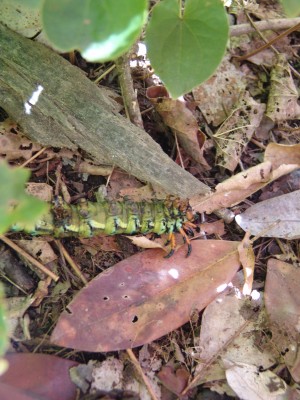Hickory horned devil
Hickory Horned Devil
Citheronia regalis

Yesterday we found a hickory horned devil outside of the Arboretum offices and I was reminded of what fantastic critters they are. Their appearance can be somewhat striking to someone who has never seen one before. I remember I was shocked the first time I saw one. They have spiky horns and can grow up to six inches in length. When they are disturbed, they rear up their spiky heads, but they are actually pretty harmless. They spend the summer eating leaves of Carya, Juglans, Rhus, and Nyssa trees. This time of year they turn a beautiful shade of green and descend from the trees above.
If snakes or other predators don’t eat them, they will burrow into the ground and turn into shiny brown pupae. They will stay underground for one or two winters and then emerge in the spring as the adult royal walnut moth, also known as the regal moth. This moth is orange-striped with yellow markings and can have a wingspan of up to five and a half inches.
Be on the lookout for these amazing caterpillars this September!





gloria
Posted at 10:16h, 18 Septembermy husband and i found one of these beautiful caterpillars last week(mid sept) it seems to have shrunk since we’ve had it it has totally de-leafed a 15 year old black walnut in my yard i’ve found a nice soft dirt pile and am wondering if it would have burrowed by now if ii hadn’t kept it ?????? am trying to find out info on it (her?him?)
Bill Costello
Posted at 14:08h, 23 SeptemberHickory horned devil caterpillars belong to the Giant Silkworm or Royal Moth group which is the Saturniidae family. This group overwinters as a pupa in a cocoon usually attached to a small twig and they emerge as adults in the spring. Because of their size they can consume impressive amounts near the end of their life cycle